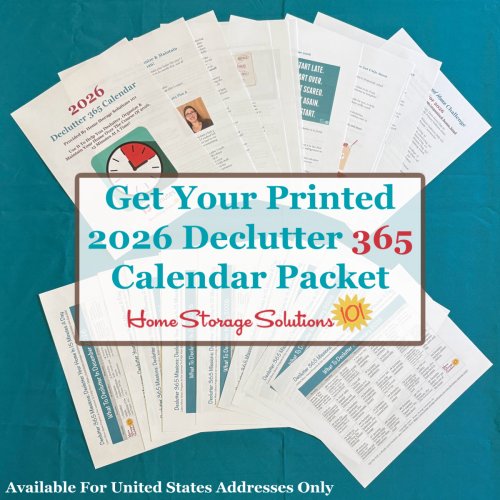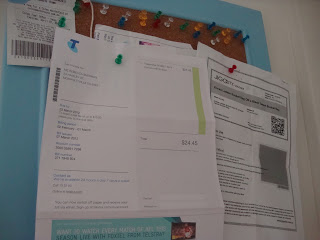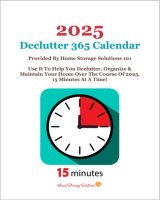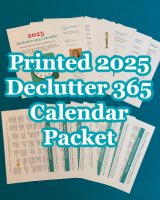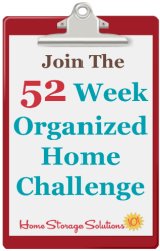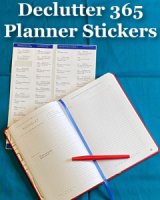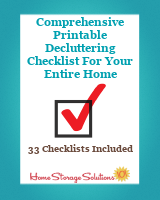
Organizing Bills Hall Of Fame: Ideas & Solutions
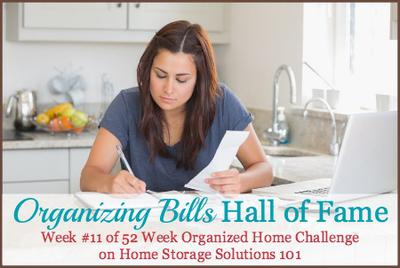
Here is a hall of fame, showing how lots of participants of the 52 Week Organized Home Challenge, go about organizing bills in their homes.
If you haven't already read it, make sure to check out the challenge article which deals with how to organize bills, which is the basis for this hall of fame article.
There are, as always, lots of ways to go about organizing just about anything in your home, and bills are no exception.
You can gets lots of practical ideas below, from real people, about how they do it, which I hope will inspire you.
There are several parts to organizing bills, including:
- Keeping track of the bills when you receive them, so they don't get misplaced or lost within the rest of your mail;
- Tracking due dates for your bills, so you know when you have to pay them, so they're paid on time; and
- How to organize the bill stubs and paperwork generated by the bills, after they're paid
One theme I noticed in many of these ideas that were shared is that the readers had all developed a routine that they followed faithfully, for when they received the bills, paid them, and filing and organizing the papers afterward.
I would also love to see how you tackle this area of your home as well. Remember, you can submit your own pictures here for the Home Organization Hall of Fame and I'll add the best ones to the page.
Scroll on down to see the ideas already shared!

How I Gather Up Unpaid Bills To Be Paid

Linda sent in the photo above, showing the method she uses to gather up all of her unpaid bills, as she receives them in the mail on a daily basis.
She said, "I use a thirty-one tote, fits on my desk, back section for bills to be paid, front section holds stamps, return address labels. Outside mesh pockets, one side pens, the other letter opener and scissors.
Mail is dealt with as it comes in. Junk is recycled/trash, magazines have a spot in the living room for availability to enjoy. Any incoming for file is filed right away.
Weekly I check the bills to be paid, taking care of those including any filing.
Love this tote, very portable.
Since my desk is also in the guest room, should I have company, I can grab this, removing it from the guest room, and still have everything I need without bothering guests."
Good idea Linda, and I love your routine. Sounds like it really works for you.
I encourage everyone to have some type of container where they can place unpaid bills, and other items they receive in the mail, so they know where everything is, and can take action on the items you gather regularly. (You can get lots of ideas in the Mail Organization Hall of Fame here if you want to check them out.)
You can learn more about what I suggest you do in a weekly paperwork session here.

Use A Bill Binder Or Notebook For Organizing The Bill Paying Process

A couple of readers have sent in photos of the notebook or binder system that they use, to give you ideas for yourself.
The photos above were sent in by a reader, Diana. She said, "Best little book I have ever found. It has pockets for each month to put unpaid bills in and to also keep receipts organized. I write down the bills as they come in and check mark when they are paid and the date. Excellent for someone with chemo brain :) "
In addition, Marlo sent in the collage of photos below, showing her entire bill binder system.

Marlo said, "This is our current bill binder, which I will be updating tonight. I started this in 2010 after taking the Dave Ramsey FPU Course.
Time to update, change section tabs, new forms etc. It really has been great to keep everything bill related together so I didn't have to search for budget forms, bills, checkbook and the like.
It's time declutter and add in new features to better maintain bill payments, form and other essential budgeting materials."
I Use A Tickler File For Paying Bills On Time
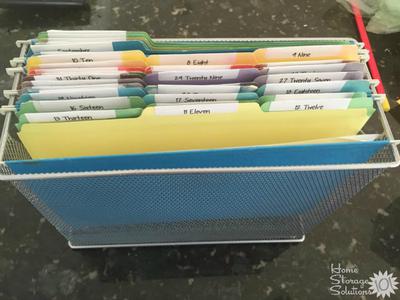
A reader, Brandy, wrote in to say her system for paying bills on time, a tickler file.
Brandy said, "I have been using a tickler file for years. However, I simply use expanding files without the flap.
I use one with January - December that I replace annually.
I also use the 1-31 that is used over and over every year.
Along with a calendar, these two expanding files get the tickler job done.
When I write a bill or event on my calendar, I place the bill or tickets/info in the same day slot in my expanding file.
When I see the bill due date and/or event has arrived I know I can find it in that day's number in the file.
As I pay bills, finish with receipts, or find any other item that occurred in a certain month and needs to be kept, I just place it in the current month. At the end of the year, I have a portable file of the year that fits nicely with other end of the year items.
Thanks for sharing what you do Brandy! I love a tickler file myself, and it is great for making sure you pay bills on time.
If you're not aware of what a tickler file is exactly, no problem. Here's my article on how to create a tickler file so you can use a system like Brandy's if you're interested.
Some people use something similar to a tickler file just for organizing their bills, it's called a 31 slot bill organizer.
These organizers work in a similar way to a tickler file, having 31 slots for all the possible days of the month, and when you open your bills up and see their due date you can place the bill in the right slot. For example, if your bill is due on the 7th of the month, put it in the 7th slot.
Using this bill organizer you can visually keep track of when bills are due, and make sure you pay them in plenty of time.
Here's an example of such a bill organizer used by a reader, Marie. She said, "My hubby built me this organizer with 31 slots so I can open bills right away and then put them into the slot for what day it is due.
I haven't put numbers on the slots yet, but you get the idea. It hangs on the wall since our counter space is minimal."

While Marie's husband made her organizer for her, there are many of these bill organizers also available for purchase.
Here are several examples:
31 Slot Bill Organizers {Referral Links}
Top photo courtesy of a reader, Cathy
I Use A Chart Of Expected Bills & Follow A Routine
by Sally
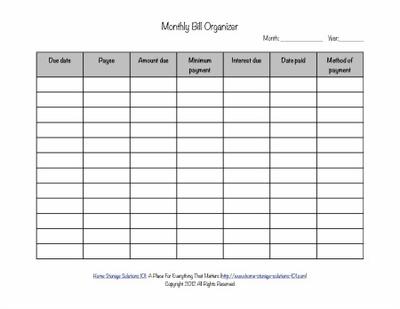
Sally says:
I follow my father in law's teaching. I have a chart of all expected bills.I have most of them automatically paid, but the few I have to send a payment in for are done twice a month.
I check off the bills on the chart as they clear the account.
As bills come in I open them, make sure they are right, and then they get filed in the folder which holds that chart, until I pay them.
After they clear the bank I move those bills to a file for 90 days (just in case) then they get shredded.
I love the chart, because at a glance I can tell if everything that should have been paid has been!
Taylor says:
Thanks for sharing your routine Sally. This sounds great, and the most important takeaway is that you follow a habitual routine.That is what is most important for keeping track of your bills, dealing with them consistently.
The photo of the chart above is actually the free printable monthly bill organizer worksheet that is available on this site. So for those who want to try something to Sally, be sure to grab your copy today.
Calendar To Track Bill Due Dates & Accordion File For Filing Them Afterward
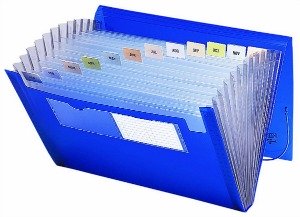
One reader wrote in to share her system for organizing bills, and said: "When I receive a bill I add the due date to my paper desk calendar and Google calendar.
Then I file the bills in a folder marked "To Pay/To Do."
When paid, I file the bill in a 12 pocket accordion file by the month. When the year is over, I already have my bills filed and the whole accordion file can go into the file cabinet.
During the year, the accordion file sits in a file bin on the window sill in my office with the "To Pay/To Do" folder sitting in front.
In the same file bin, there are also folders behind the accordion for "Taxes", "Health", "Retirement", etc.
Low tech, but it works very well for me."
This method that she described is actually exactly what I suggest for how to organize paid bill statements. You can read the article at the link.
In addition, you can get these types of expanding files here:
Expanding Files {Referral Links}
Photo courtesy of Amazon.com
Bill Organization Before & After Paid
by Bec from 2012 - The Year Of Challenges
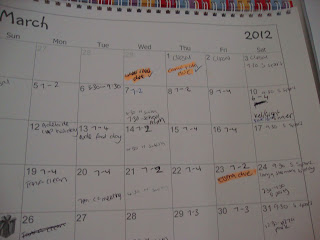
Calendaring due dates
Bec from 2012 - The Year Of Challenges took on this week's challenge, and shared how she does it both before the bill is paid, and also afterward.
Before the bills are paid she makes sure she doesn't lose the paper by pinning it to her pin board.
The one with the due date closest is in the front of the stack that is pinned to the board.
But she found that alone was not enough, so she also began adding the due date of bills to her calendar which she looks at daily.
She explained, "I have highlighted the bills so I can see at a quick glance when they are due. Once paid I tick it so I know it's dealt with."
Then, finally, after they are paid she adds the information to a spreadsheet, and files the actual paper bills.
Here's a screen shot of her spreadsheet for paid bills:

She also made progress clearing out the filing cabinet of older bills that she didn't need to keep anymore, shredding them.
Great job Bec! Looks like you've got a system that works well for you.
In addition, here's an idea from another reader, Candace, who uses envelopes to help her organize and file her old paid bill stubs. Candace explained, "I use the envelope system. Long white business envelopes. I use a marker to put the name of the bill and the year on the envelope. I've been doing this 42 years! I usually have about 12 envelopes and put them in alphabetical order and keep them in a shoebox!"
She said that the photo below is a picture example of one of the envelopes she uses.

I Collect My Bills In A Wall Mounted Mail Rack
by Taylor

I pay bills once a week, when I also do my weekly paperwork session.
That's also when I meal plan, balance the checkbook, call about bills or other issues that need to be dealt with, do my banking, run errands, etc.
But I've got to have a place to hold the bills until then, as they come in the mail.
What has worked for my family is to use a wall mounted mail rack similar to the one shown above.
That solves the problem we used to have prior to this arrangement where we just laid everything, including junk mail, magazines, bills, etc., on the kitchen table and a couple weeks later we might run across it. Or we might forget completely and get a shock the next month when the bill was double, plus a whopping late fee.
That system, if you could call it that, was not good on our wallets since we paid a lot of late fees. That was silly since if we'd just had a routine in place we had the money to pay the bills when they were due.
Now, I don't worry about missing or late payments since I pay all the bills in the stack, or if I can (and want to) put off a bill a week I will if the due date won't be coming up too much after the next weekly paperwork session.
Then, after paying the bills I just place the paid bills in that month's paid bill folder. I used to have a folder for each type of bill, but I found that frankly that was too much work for rarely ever referencing those bills again.
Therefore, this system of one file folder for each month of paid bills is good enough for us, for most things.
Then it's easy after two or so years to just throw away almost everything in those files (well, technically shred and then recycle). I might save out one or two things to file somewhere else, but not much since no one cares two years later if you paid your phone bill, typically.
Wall Mounted Mail Racks {Referral Links}
Are You Ready To Get Organized Now?
I hope the ideas you've seen in this hall of fame have inspired you.If so, I encourage you to do the Organize Bills Challenge and then submit your photos to the Hall of Fame here, and I'll the best ones to the site.
In addition though, I'd love it if you joined the 52 Week Organized Home Challenge, where each week we tackle a different room or type of item in your home. Over the course of the year you'll organize your entire home and life from top to bottom, while also developing positive habits and routines to help you keep it that way!

Wall mounted mail rack photo courtesy of Amazon.com
Some links on this page are affiliate links, meaning that if you purchase a product through them I receive a small commission which helps me provide this information to you for free, plus support my family. My integrity and your satisfaction are very important to me so I only recommend products I would purchase myself, and that I believe would benefit you. To learn more please see my disclosure statement.
Related Pages You May Enjoy
Getting Rid Of Bill Clutter Hall Of FameGo From Organizing Bills Hall of Fame To Home Page
Comments for I Collect My Bills In A Wall Mounted Mail Rack
|
||
|
||
|
||
|
||
|
||
|
||
|
||
|
||
|
||
|
||
|
||
|
||
|
||
|
||
|
||
|
||
|
||
|
||
|
||
|
||
|
||
|
||
|
||
|
||
|
||
|
||
|
||
|
||
|
||
|
||
|
||
|
||
|
||
|
||
|
||
|
||
|
||
